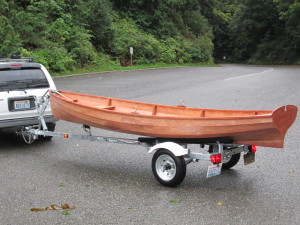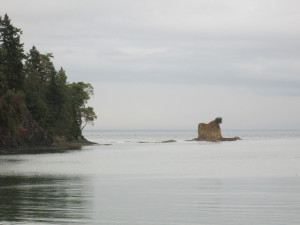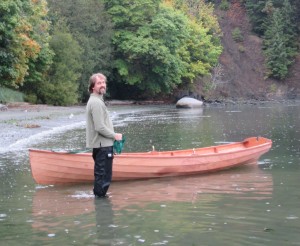A new boat comes to life by degrees. As individual parts come together the construction takes on a form that makes it’s function apparent. It becomes a vessel gradually. A boatbuilding project can take a long time and bring doubts about the wisdom of having started the enterprise. The moment you can look at the vessel and think to yourself, “damn this thing is going to float” the first spark of life is infused into the somnolent hull. The builder gains the first elements of accomplishment that will add up to full-blown pride by the time the project is complete. Still, the boat is a silently sleeping concept. It remains a construction of earthly materials in suspended animation until the moment it is touched by water and settles on her lines like a dancer at the barre ready to execute a graceful arabesque.
The whole reason for being of Dave’s building the Chester Yawl was rooted in an idea surrounding making a business of putting kit boats together for people with the desire but not the skill to execute such a project. He is more of a kayaker and power boat enthusiast and he almost chose a kayak design. In the end he chose to go with a design that had a classic look. The boat would be a salesman’s sample, so to speak. The unpredictable nature of life in these financially interesting times can make it hard to focus on this kind of effort. It makes one want to strike while certain proverbial irons are still hot. The unsettled nature of things made Dave anxious to see his creation floating and find out how it handled underway.
Dave’s plans were originally conceived while he was still working at Westport Shipyards. We discussed his ideas often. He bravely invited my advice and snarky criticism. Keep in mind that my wife calls me Mr. Negative. As a sort of unidicted co-conspirator and occasional builder’s helper he also wanted me to be a part of the preliminary launching and sea trial. We settled on a mutually convenient Sunday afternoon to splash the not quite finished craft. The hull was thoroughly coated with epoxy and all the parts were in place. Everything left to do was cosmetic so a bit of a wetting wouldn’t do any harm. As it turned out the weather was not cooperative and we weren’t able to borrow a set of oars that we were counting on.
The urge to launch was just too strong and we determined to make the best of it. We loaded the yawl onto it’s trailer and set off for Freshwater Bay with a stop at my house to get a pair of canoe paddles. I have two paddles. One is a classic beaver tail made from one piece of red cedar. The other is a spruce model with a more squared off blade and good balance. The loom blends into the blade with a central ridge and an absence of excess material as seen in a good set of oars. It generates a lot of power and makes a good rudder. All the best canoe paddles I’ve ever owned were carved by myself or purchased at flea markets for very little money. We figured they would do in this particular pinch.
The overcast day was producing pockets of rain in the drizzly tradition of the Pacific Northwest. I had looked at the radar weather report on the computer. I could see that we would almost certainly get a little wet but could also luck out and stay dry or become completely soaked. Heading west on State route 112 we generally increase your chances of precipitation and so it did that day. Arriving at the launch area on Freshwater Bay we found it unoccupied. The supply of maritime masochists in Port Angeles was temporarily in short supply. We donned a patchwork of rain gear and backed the trailer into the water.
Launching a boat calls for a certain amount of ceremony. Neither Dave or myself have either viking or Greek blood in our veins and so had not bothered to procure anything suitable for sacrifice to the pagan gods. In any case the killing of rams is not allowed on state lands. The fallen rain was sufficient to christen this small boat that, in any case, had no name. Actually, I think we just forgot the idea in the hubbub of gathering the required life preservers, figuring out the best way to strap the boat down on the trailer and generally enjoying the Huckleberry Finn like zeitgeist of the moment. Naturally, the rain had returned for the occasion and the clouds were heavy and low. I would call the conditions marginal and would have cancelled if there had been any wind added to the mix. Fortunately, in spite of rain and gloom and the distant rumble of thunder the bay was pretty much a mill pond. We did resolve to stay within easy paddling distance of the shore where it was lined by a gravel beach and not the jumbled piles of rock that lay in wait farther along the coast.
Our purpose was not to travel any far distance. It was to give the boat it’s first wetting and survey it’s stability and maneuverability. This may not have been the ideal place but it seemed suitable to me and Dave knew it well from kayaking in the area. Freshwater Bay is an open bight along the top of the Olympic Peninsula with a small islet that rises near a point on the western end of the bay. It is a rocky remnant of a high bluff with a gravel beach along it’s base.
I chose the stern seat and Dave sat forward on the seat that was there due to the modification of the original CLC design. Although our launch was without fanfare there was a sense of celebration to be sitting in the boat for the first time with nothing beneath us except water. the yawl was in good trim and and felt quite stable. Some deliberate rocking demonstrated the boats basic tendency to remain upright. Paddling away from the beach she showed enough slipperiness to produce a pleasing rate of speed. The water was smooth for the first hundred yards off the beach. It was ideal for finding out how well the boat tracked and how easily she turned. The Chesapeake Yawl is a recreational rower that works as a good compromise between narrower wherry and exercise rowing shells. She feels a lot like some of the Swampscott dories I’ve rowed. Although we were using paddles in an asymmetric fashion the yawl handled well. I was able to turn the boat and steer from the stern in an effective manner. It seemed clear that with a pair of good seven and a half foot oars the boat would acquit itself well. Dave was obviously pleased with the way she glided through the smooth water and urged us away from the shore.
The rougher water of the Straits could be seen ahead and as we drew even with the islet the wave action of the Straits of Juan de Fuca began to be felt. The rise and fall of the swells which are but an echo of the movement of a large body of water were a further test of this craft. She moved easily over the swell. There was arythmic pattern that built the swell higher every six or seven waves. There was definitely a point past which it would not be prudent to go. Especially as one could see the strong set of the tidal current referenced against features along the shoreline. At a point that was still reasonably safe we turned and ran parralell to the shore edging the imaginary boundary of the bays protection.
Dave is a kayaker and has a taste for broken water. It’s been my impression that Dave’s enthusiasm for this little open boat had waned a bit over time. He didn’t seem quite in sync with the spirit of the craft. Even small boats can seem like a commitment and you need to feel connected. If you don’t really know what the boat is about it can go from graceful swan to albatross in the turning of a tide. Dave and I usually keep up a steady stream of chatter as we work. It was no different on the water. It had been running along the lines of technical issues about trailering and the usual sharing of nautical experiences. As we paddled along the steady drizzle counted for nothing as we concentrated on evaluating and appreciating this fine thing that had been built. Dave sat at his station with paddle in hand occasionally turning enough to speak more directly. His steady grin spoke volumes and showed that a sea change had come along.
The chill in the air and the distant rumble of thunder dictated a turn to shore. We timed it with the smaller waves to spend the least amount of time broadside to the waves. The yawl came about in fine fashion and impressed me with her handiness. You can get into trouble with any boat but give me one that doesn’t bury her bow and has lots of reserve bouyancy and I always feel good about my chances of coming back dry and happy.
When we got back to the ramp Dave went to get the car and trailer. I held the boat off the beach standing in water half way up my calves. The boat kept trying to ride the waves toward the shore and I would give her a shove so that she glided out to the end of her painter. She made a pleasing sight riding high and light on the water. It reminded me of the small, delicately beautiful, Fairy Terns I enjoyed so much on the Chesapeake Bay. They were small and graceful. As my boat swung to the anchor I would stand in the cockpit as they glided within reach of the bread I held in my outstretched hand. They hung on the wind as if suspended by hidden engines, high tech marvels clothed in sleek feathers.
Getting the boat back on the trailer was an easy matter. We knew we had gotten off the water at the right time as lightning accentuated a peal of thunder. We quickly finished our preparations and drove away. Conversation flowed around the ease of motion and maneuverability we had experienced. A note of uncertainty that I had always thought I heard in Dave’s speculations about the boat was totally absent. It seemed like he had finally fallen a little bit in love with this slender craft. No longer just a building project that consumed time and resources the Chester Yawl had proved itself to be worth the effort of building.





